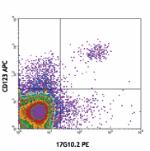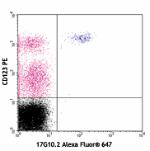- Clone
- 17G10.2 (See other available formats)
- Regulatory Status
- RUO
- Other Names
- CD85g, immunoglobulin-like transcript 7, LILRA4
- Isotype
- Mouse IgG1, κ
| Cat # | Size | Price | Quantity Check Availability | ||
|---|---|---|---|---|---|
| 326413 | 100 µg | $270.00 | |||
| 326414 | 1 mg | $743.00 | |||
Select size of product is eligible for a 40% discount! Promotion valid until December 31, 2024. Exclusions apply. To view full promotion terms and conditions or to contact your local BioLegend representative to receive a quote, visit our webpage.
ILT7 (immunoglobulin-like transcript 7) is a member of leukocyte immunoglobulin-like receptor (LIR or LILR) gene family, also known as CD85g and LILRA4. It contains four extracellular Ig domains. In association with FcεR1γ, ILT7 forms a receptor complex that transduces ITAM-mediated signals. ILT7 is specifically expressed on plasmacytoid dendritic cells (pDCs), but not on myeloid dendritic cells and other peripheral blood leukocytes. ILT7 negatively regulates the innate immune functions of human pDCs. Cross-linking 17G10.2 antibody is able to trigger ILT7 mediated signaling.
Product Details
- Verified Reactivity
- Human
- Antibody Type
- Monoclonal
- Host Species
- Mouse
- Formulation
- 0.2 µm filtered in phosphate-buffered solution, pH 7.2, containing no preservative.
- Preparation
- The Ultra-LEAF™ (Low Endotoxin, Azide-Free) antibody was purified by affinity chromatography.
- Concentration
- The antibody is bottled at the concentration indicated on the vial, typically between 2 mg/mL and 3 mg/mL. Older lots may have also been bottled at 1 mg/mL. To obtain lot-specific concentration and expiration, please enter the lot number in our Certificate of Analysis online tool.
- Storage & Handling
- The antibody solution should be stored undiluted between 2°C and 8°C. This Ultra-LEAF™ solution contains no preservative; handle under aseptic conditions.
- Application
-
FC - Quality tested
FA - Reported in the literature, not verified in house - Recommended Usage
-
Each lot of this antibody is quality control tested by immunofluorescent staining with flow cytometric analysis. For flow cytometric staining, the suggested use of this reagent is ≤ 0.5 µg per million cells in 100 µL volume. It is recommended that the reagent be titrated for optimal performance for each application.
- Application Notes
-
Additional reported (for the relevant formats) applications include: trigger ILT7 mediated signaling.The Ultra-LEAF™ purified antibody (Endotoxin < 0.01 EU/µg, Azide-Free, 0.2 µm filtered) is recommended for functional assays (Cat. No. 326413 and 326414).
-
Application References
(PubMed link indicates BioLegend citation) -
- Jensen MA, et al. 2013. Ann Rheum Dis. 72:596. PubMed.
- RRID
-
AB_2860854 (BioLegend Cat. No. 326413)
AB_2860854 (BioLegend Cat. No. 326414)
Antigen Details
- Structure
- Associate with FcεR1γ leukocyte immunoglobulin-like receptor gene family
- Distribution
-
Plasmacytoid dendritic cells
- Function
- Negatively regulates pDC mediated innate immune function
- Cell Type
- Dendritic cells
- Biology Area
- Immunology, Innate Immunity
- Molecular Family
- CD Molecules
- Antigen References
-
1. Cao W, et al. 2006. J. Exp. Med. 203(6):1399.
2. Brown D, et al. 2004. Tissue Antigen. 64:215.
3. Rissoan MC, et al. 2002. Blood 100:3295. - Gene ID
- 23547 View all products for this Gene ID
- UniProt
- View information about CD85g on UniProt.org
Other Formats
View All CD85g (ILT7) Reagents Request Custom Conjugation| Description | Clone | Applications |
|---|---|---|
| PE anti-human CD85g (ILT7) | 17G10.2 | FC |
| Alexa Fluor® 647 anti-human CD85g (ILT7) | 17G10.2 | FC |
| Ultra-LEAF™ Purified anti-human CD85g (ILT7) | 17G10.2 | FC,FA |
| TotalSeq™-C0409 anti-human CD85g (ILT7) | 17G10.2 | PG |
| TotalSeq™-B0409 anti-human CD85g (ILT7) | 17G10.2 | PG |
| Brilliant Violet 421™ anti-human CD85g (ILT7) | 17G10.2 | FC |
| Spark Red™ 718 anti-human CD85g (ILT7) (Flexi-Fluor™) | 17G10.2 | FC |
Compare Data Across All Formats
This data display is provided for general comparisons between formats.
Your actual data may vary due to variations in samples, target cells, instruments and their settings, staining conditions, and other factors.
If you need assistance with selecting the best format contact our expert technical support team.
-
PE anti-human CD85g (ILT7)

CD14- human peripheral blood mononuclear cells st... -
Alexa Fluor® 647 anti-human CD85g (ILT7)

Human peripheral blood mononuclear cells stained with CD123 ... -
Ultra-LEAF™ Purified anti-human CD85g (ILT7)
-
TotalSeq™-C0409 anti-human CD85g (ILT7)
-
TotalSeq™-B0409 anti-human CD85g (ILT7)
-
Brilliant Violet 421™ anti-human CD85g (ILT7)

Human peripheral blood mononuclear cells were stained with a... -
Spark Red™ 718 anti-human CD85g (ILT7) (Flexi-Fluor™)
